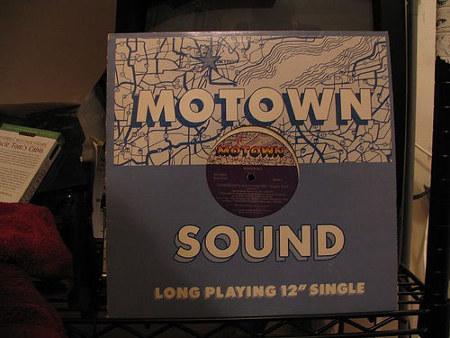 In 2011, Chrysler’s advertisement for its new model 200 sedan debuted at the Super Bowl. What made this commercial different was its locating of its product in the city of Detroit, playing on and reworking its economic and cultural history. Shana Redmond argues that the advertisement is notable for the absence of both the sight and sounds of the city’s black population, a population that has been intimately involved with automotive production for decades in Detroit. She writes that Chrysler has advanced the concept of consumption as a means towards national vitality, at the expense of not portraying the importance of the city’s laborers.
In 2011, Chrysler’s advertisement for its new model 200 sedan debuted at the Super Bowl. What made this commercial different was its locating of its product in the city of Detroit, playing on and reworking its economic and cultural history. Shana Redmond argues that the advertisement is notable for the absence of both the sight and sounds of the city’s black population, a population that has been intimately involved with automotive production for decades in Detroit. She writes that Chrysler has advanced the concept of consumption as a means towards national vitality, at the expense of not portraying the importance of the city’s laborers.
During the half-time show of the National Football League’s 2011 Super Bowl – the most-watched annual sporting event in the US – Chrysler Group LLC premiered the commercial for their new model 200 sedan. With popular rap emcee Eminem (né Marshall Mathers) in the driver’s seat, the viewer is taken on a ride through Detroit, the once lauded hub of American auto production. The camera offers quick flashes of iconic city scenery alongside interior and exterior shots of the 200 in an attempt to locate the product within a similarly consumable geography. Even with these visuals, the commercial is notable first for what is absent; it reworks Detroit’s economic and cultural histories in order to launch a product intimately tied to the past that it dismisses. What we don’t see is what we don’t hear within Chrysler’s pitch: the work and sounds of auto production, a ghost industry that, in spite of limited material impact within the city’s employment record, has continued to generate consumer goods.
Entitled ‘Born of Fire’, the Chrysler commercial begins in a documentary film style that attempts to (re)present an authentic Detroit. The fire used to name the ad is not a reference to the 1943 uprising at the Sojourner Truth projects over housing integration, nor to the five-day insurrection of 1967 over police harassment and surveillance in Black neighborhoods. The devastated landscape represented in the commercial, which juxtaposes miles of abandoned buildings with the skyscraping corporate infrastructure of the downtown core, hints at a city of evacuation and greed, even while it uses this geography to encourage consumer purchase. But what are viewers being asked to buy? There are at least three products in this commercial that, in combination, chart the struggles for and over a major US city: the 200 sedan, Eminem and Detroit are the commodities that feed a national narrative of dispossession through the conjoined projects of labor, music and location.
The entanglements of music and labor are not just the sounds of production, important as those are; there are dynamic resistances that circulate through labor, including sonic transgressions that do more than move and pace it – music shapes our perception of work and those (not) performing it. While the manual labour of Detroit is important to account for, it is the absence of it that animates Chrysler’s commercial. With its ‘Imported from Detroit’ sloganeering, the commercial relies on sonic techniques and traditions that radically displace cultural and labour trades from car production and its imagined site of origin, Detroit. The dual performances of work and music within ‘Born of Fire’ are collapsed; music emerges as the dominant product and is used by Chrysler as shorthand for a prosperous national future delivered via the ‘foreign’ city of Detroit.
It seems an obvious statement but Detroit is a place apart. It is variously situated within national imaginaries as both a beacon of hope and an archetype of decline. The hollowed-out and bankrupt city interior that marks Detroit’s current condition is not its history, nor even the totality of its present; rather it represents a moment on a continuum of important socio-political and economic shifts that compel further consideration. Thomas Sugrue dates the origins of Detroit’s urban decline to the 1940s and 1950s, decades in which the post-second world war economic high quickly faded. He notes that:
‘Since 1950 Detroit has lost nearly a million people and hundreds of thousands of jobs’, effectively displacing entire generations of people. This crisis, made up of myriad socio-political elements including housing and education, is attributable to ‘two of the most important, interrelated, and unresolved problems in American history: that capitalism generates economic inequality and that African Americans have disproportionately borne the impact of that inequality’ ( pp. 1, 5.).
It is important to contend with Detroit on its own terms, acknowledging the ways in which it is distinct and demonstrates the intersections of culture and economics within the contemporary, race-based ‘uneven geographies’ of power and access. Approaching it through its multiple productions, including sound, allows for an alternative archive and narrative of the changing physical and labor landscape of the city and its creations.
The music of Black labour and labour of Black music in Detroit
Black musics have a long history of arising from and in response to struggles within the home, workplace, community and nation. Workers, both enslaved and ‘free’, have been responsible for creating conditions of political possibility that fuse laboring status with cultural practice by refusing the inhumane demands and ideo-social limits of ‘work’. There are numerous examples of this laboring practice within Detroit but none as iconic as Motown, which developed alongside that city’s urban crisis. The company looms large within national histories of Black musical production as a home for innovative mid-century luminaries who performed the ‘race music’ on the soundtrack for a desegregating US.

The assembly of the ‘Motown sound’ through musical notation is indebted to its Detroit location; it recreated the work of the city’s many auto manufacturing plants, producing sound in a formulaic A-B-A, bubble-gum major key in order to keep pace with the rest of the Motor City and its many locales of influence internationally. Motown founder and president Berry Gordy, Jr’s reliance on the industrial tradition of Detroit developed when he was a worker in the Ford Wayne Assembly Plant. Hitsville was its own manufacturing plant but, instead of rubber and steel, Gordy’s raw material was Black talent and bodies whose ‘baby, baby, baby’ sounded the pulse of production.
Motown’s flight from Detroit to Los Angeles in 1972 was indicative of larger labour trends, which failed to provide the economic base necessary to meet the needs of its citizens. Detroit’s transition from a metropolis with a substantial and vibrant Black middle class in the 1950s to an industrial wasteland in the 1970s was precipitated by the state-level policies of moderate Republican governor and former auto executive George Romney and a national fuel crisis that led to the quick and penetrating decay of US auto manufacturing. Detroit ceased to sound the same with the exit of mass production; the rhythms that once signaled full stomachs and a vibrant Black public sphere were evacuated in the wake of capital’s flight.
The sound of unemployment
Detroit did not struggle with responses to this condition in isolation. The rapid decline of the US economic base in 1970s’ New York facilitated the development of a radically altered soundscape through the multimedia enterprise of hip-hop. Urban areas throughout the country (and later the world) responded in kind, implementing new techniques of sound, aesthetics, technology and dance that expanded the potential of the form even as they localized its production through unique regional characteristics. The economic decay did not dissolve hip-hop’s attachment to labor, however; it instead reconstructed and amplified it in alternative ways, including the innovation of laboring techniques by DJs and emcees.
Eminem was the emcee who became the international face of Detroit hip-hop. He landed in the city as a teenager and quickly expanded his lyrical presence, gaining the attention of Interscope-Geffen-A&M Records Chairman Jimmy Iovine after he placed second at the 1997 Rap Olympics. His 1999 release, The Slim Shady LP, criticized for its homophobia and misogyny, nonetheless went quadruple platinum. To his credit, his public persona has matured alongside his lyricism and since 1999 he has been a prominent figure within Detroit, even working with elected officials. He was a major supporter of the nation’s first ‘hip-hop mayor’ Kwame Kilpatrick, who won the Detroit office in 2002, the same year that Eminem released his motion picture debut, 8 Mile. In it, Mathers plays Jimmy ‘B. Rabbit’ Smith, Jr, a working-poor white kid from the trailers just north of Detroit’s fabled 8 Mile marker. An aspiring emcee with a day job at an auto factory, Rabbit begins the film (set in 1995) broke and broken, with no girlfriend, no car and en route to a stay at his alcoholic mother’s trailer after choking on stage during a rap battle. The accompaniment to this series of events is a deconstructed piano rendition of ‘Lose Yourself’, the film’s Academy Award winning song and that which animates the Chrysler 200 commercial.

The last time that the 8 Mile audience hears ‘Lose Yourself’ is after Rabbit bests three emcees (all of them Black) in order to walk away with the rap title, but instead of going to celebrate with his friends, he returns to his shift at the factory as his anthem plays. The film’s repeated use of ‘Lose Yourself’ and Rabbit’s return to the auto factory are significant because, in tandem, they show the connection between industrial Detroit and contemporary hip-hop missing in the Chrysler commercial. Chrysler’s two-minute treatment is only interested in alluding to economic destruction – and the potential for solidarity in consumption – as a means by which to situate its commodity as the answer.
The 200 model sedan is marketed as the fleshy-steel material embodiment of the optimism and hard work so prominent within the narrative of ‘Lose Yourself’, which encourages the listener to ‘Lose yourself in the moment./ If you want it,/ you better never let it go./ You only get one shot,/ do not miss your chance to blow./ This opportunity comes once in a lifetime.’ The narration offered in ‘Born of Fire’ similarly adopts a tone of hardscrabble optimism. The male voice leading us on our tour argues that ‘It’s the hottest fires that make the hardest steel. Add hard work and conviction and the know-how that runs generations deep in each one of us – that’s who we are. That’s our story.’ The collective ‘our’ used here is an imagined community organized to fit inside the advertisement of Chrysler’s corporate character, which includes revivalism, strength over adversity and glamour. Viewers are led to believe that the unity amongst the group lies in its shared misinterpretation, which can only be resolved through the local expertise and products of Chrysler. The narrator decries and dismisses those ‘who don’t know what we’re capable of’. Their ignorance, he argues, is due to the fact that they have ‘never even been here’ – to Detroit, the city that Chrysler claims but cannot materialize.
Chrysler’s dismissal of larger economic contests is accomplished through privileging the commodity and minimizing the workers behind its production. The ‘Born of Fire’ 200 is immaculately conceived. In spite of the ‘us’ and ‘our’ so loosely employed by Chrysler, the bodies who produce the commodity are disappeared. There is no labor. Historian Dana Frank argues that this practice is not new; throughout the long history of ‘Buy American’ campaigns, the products of labor are highlighted as the means by which US labor would survive, versus respecting and preserving the labor itself. The auto industry in the US has been and continues to be one of the stars within these campaigns. By the early 1990s, the extranational flight of production allowed for the so-called ‘U.S. auto industry’ to be ‘neatly separable from any actual workers laboring in the United States’. These companies then argue that value is only found in commodities, allowing Chrysler to advance consumption as the method of national vitality.

The final statement of ‘Born of Fire’ sets the ultimate tone for Detroit’s difference; as the imagery fades to black, the ominous tag ‘Imported from Detroit’ appears as cover for the Chrysler logo. These three words allude to the dislocation and marginalization of this US city but fail to acknowledge how foreign-ness signals a radical and centuries-long struggle over whose lives matter and whose do not. Used to manufacture fear in times of war and economic recession, the rhetoric and practice of the ‘import’ has long brought with it material social, political and economic consequences. Its pairing with Detroit by Chrysler plays to and mediates national fears through the commercial’s distortion of the city’s uneven geography. The continued displacement of and lack of resources for Black communities, in the wake of incarceration, rebellion and disaster, documents the alternative citizenship categories ascribed to these persons who are within but not of the nation.
‘Born of Fire’ is not so much interested in resituating or resuscitating Detroit as in damage control for the national image of the auto industry in the wake of the 2009 federal bailout. Instead of celebrating Detroit, Chrysler uses its commercial platform to entrench practices of evacuation by absenting the city’s populations, laboring and otherwise, and privileging the vehicles that would protect consumers from having to walk its streets. The end of labor is seen here through that commodity, which is a composite structure of imported and domestic pieces that relate to one another within a world of things, not people. Chrysler’s claims to luxury are undercut by the wageless life that the 200 bypasses in the streets of a city that now, with the exit of industry, lives and listens differently. That Detroit no longer sounds like car manufacturing is a cruel irony that reveals Black people’s violent separation from the means of production and the products that could make their escape from poverty and abuse possible. The sounds that now fill that space must pick up where the former left off so that Detroit’s new soundtrack will carry the potential for change into this millennium.
This article is based on the paper ‘Detroit’s idle: the domestic sounds of labour’s foreign landscape’, in the July-September 2013 issue of Race & Class. The article is now open access, thanks to Sage.
Please read our comments policy before commenting.
Note: This article gives the views of the authors, and not the position of USApp– American Politics and Policy, nor of the London School of Economics.
Shortened URL for this post: http://bit.ly/1aVSjUa
_________________________________
 Shana L. Redmond – University of Southern California
Shana L. Redmond – University of Southern California
Shana L. Redmond is Associate Professor of American studies and ethnicity at the University of Southern California and the author of Anthem: social movements and the sound of solidarity in the African diaspora (NYU Press, 2014), which examines the sonic politics performed amongst and between organized Afro-diasporic publics in the twentieth century. She tweets @ShanaRedmond.






